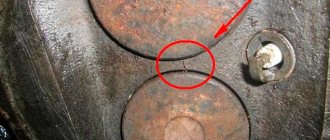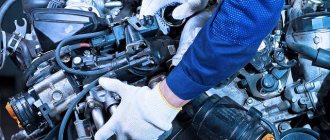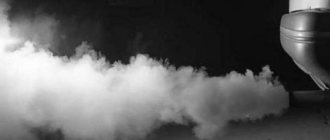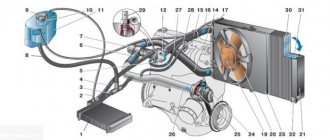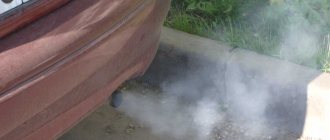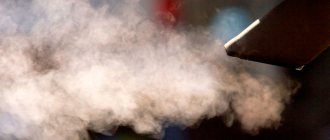Why does the engine smoke white smoke and stink?
Noticing that your engine is smoking white smoke does not guarantee that the cause is water vapor. The latter has a number of features.
- Low density.
- Dissipates very quickly.
- There is no foreign smell - for example, burning.
- After the engine warms up, it disappears after 1-2 minutes as soon as the unit reaches operating temperature.
But when the engine still smokes white even after a good warm-up, it's most likely time to check the functionality of the cooling system. Shades vary depending on the type of coolant used. One way or another, the owner is obliged to transfer the car to a service center so that the technicians can conduct computer diagnostics and then repair the cooling.
Note! If a gasoline engine starts to smoke blue, and the owner does not dare to check the cooling system, this will lead to overheating of the unit in the future. The result is jamming of the valves, scuffing on the inner walls of the block and a complete replacement of the motor.
As a rule, the exhaust shade indicates the presence of:
- breakdown of the block gasket, due to which coolant leaks into the working chamber. This is confirmed by a gradual decrease in the level of antifreeze in the system;
- cracks in the cylinder head. It is necessary to repair the engine as quickly as possible, otherwise it will soon seize;
- coolant of questionable quality;
- exceeding the permissible operating temperature. If the motor begins to constantly heat up to a temperature above operating temperature, it can suddenly jam at any moment.
What is “norm”?
Before trying to spot faults, it is worth remembering what exhaust gases are, how they are formed and what they should be like in normal condition.
Exhaust or waste gases
- a product of fuel combustion in engine combustion chambers. The type of fuel used is determined by the design of the engine: gasoline, diesel or gas.
A working engine should emit colorless gases
, especially in the warm season. In winter, immediately after starting the engine and warming it up to operating temperature, the color may be whitish - this is also normal. White smoke is formed as a result of the evaporation of accumulated condensate in the exhaust system: as soon as the engine warms up, all the moisture will disappear and the smoke will again become barely noticeable. If the smoke does not go away even after warming up, this may indicate a problem.
The engine emits blue smoke
It is not uncommon for the engine to emit a lot of blue smoke. Sometimes, depending on the temperature, the color of the smoke may change to black. To determine the reason for this behavior, you need to check its behavior cold and hot.
In the cold
The main reason why blue smoke appears over time is the wear of the cylinder-piston group. List of possible faults:
- the rings in the piston grooves have wear;
- the set of oil scraper and compression rings is worn out;
- the internal walls of the working chamber have changed shape as a result of a lack of oil or the use of low quality lubricant;
- There are scoring marks on the surface of the inner cylinder walls.
Excessive smoke emission may cease only in the early stages of wear. The transition of the temperature regime to a relative norm leads to a decrease in the gaps between the rubbing parts due to the expansion of the metal.
Hot
When the engine smokes heavily even after the temperature has normalized, you will have to take the car in for cylinder diagnostics. This behavior is the beginning of a complete failure of the cylinder-piston group. With significant smoke, the oil, liquefied as a result of heating, begins to enter the combustion chamber more actively. Thermal expansion is no longer sufficient to compensate for the increased gaps.
Note!
The presence of blue smoke, reminiscent of steam, from the exhaust of a car with a turbocharger installed indicates a turbine malfunction. The main reason is wear of the volute bearing, as well as oil getting on the hot part.
It is rare, but it happens that a warm engine emits blue exhaust due to a rupture of the automatic transmission regulator membrane equipped with a vacuum load sensor. This is due to the fact that the box is in contact with the intake manifold through a special pipe. When a malfunction occurs, a working motor begins to drain the automatic transmission, drawing transmission oil from it. Hence the excess combustion products, which have a specific odor (they begin to smell strongly).
Causes of smoke from the exhaust pipe
Smoke from the exhaust pipe: possible causes
Smoke from the exhaust pipe is a sign of an existing or upcoming complex breakdown that will require serious costs to correct.
Such smoke not only “tells” about the condition of the car, but also makes it possible to identify and eliminate engine malfunctions. What can smoke “tell” about and what consequences does it bring with it? Before a detailed analysis of the topic, it is important to immediately indicate that often it is not smoke that comes out of the muffler, but ordinary water vapor, which does not portend or mean anything terrible. Smoke of different colors may come from the exhaust pipe - white, black or blue. The color of each of them is determined by one reason or another and means different malfunctions.
White smoke is most likely steam, a byproduct of the engine. Its formation largely depends on the ambient temperature or high air humidity. Even in warm summer months, the formation of steam while the engine is running is normal, since its occurrence is associated with the deposition of condensate in the exhaust system. In addition, gasoline, no matter how strange it may sound, also contains a small amount of water, which comes out through the exhaust pipe when the fuel burns.
Why does a gasoline engine smoke black?
If the engine consistently emits black smoke, this indicates increased air consumption. The shade can be different: black, gray or dark gray. It occurs due to excessive soot content, which appears due to a violation of the combustion efficiency of gasoline. Checking the supply system will help eliminate smoke.
The malfunction has an indirect and sometimes direct relationship to the following symptoms:
- the engine has to be turned longer to start;
- fuel consumption increases every time;
- power drops;
- The catalyst gets very hot and then becomes clogged with soot, which is why it has to be replaced.
Blue smoke
The exhaust turns gray, different shades of blue, bluish or gray in cases of incomplete combustion of fuel or if excess oil enters the combustion chambers.
Such malfunctions are accompanied by increased fuel consumption, rapid darkening of the oil and higher waste consumption. You will be able to feel changes in the behavior of the car when accelerating: it will become less dynamic. The smell of blue smoke is also special: it resembles old Soviet motorcycles and mopeds. In these engines, a separate mixture was not yet used and the oil was specially mixed with gasoline. There can be many reasons for the appearance of blue smoke, here are just a few of them:
- disruption of fuel combustion processes due to faulty injectors, errors in starting the supply of the fuel-air mixture;
- release of oil into the combustion chamber. The reasons may be different: from an excessive oil level in the crankcase to increased pressure in the engine crankcase due to poor ventilation or breakthrough of gases from the combustion chamber;
- incorrect adjustment of spark plug gaps;
- stuck compression rings as a result of their coking lead to the formation of increased gaps in the CPG, which contributes to the breakthrough of gases into the crankcase and the release of oil into the combustion chamber.
By the way, coked rings may also be a consequence of using low-quality oil or a sign that the oil has rarely been changed. In such cases, the oil oxidizes and loses its properties long before replacement.
You shouldn’t save too much on oil, much less extend the replacement intervals. Even if you don’t have the newest or most expensive car, any repairs will cost many times more. We talked in detail about oil selection in one of the previous articles.
Unlike thick white smoke, you can drive for some distance with oil in the cylinders. And it’s better if this is the way to a car service center.
How to understand the reason
Devices with a carburetor injection system generate black smoke as a result of fuel overflowing into the float chamber. You will have to diagnose the condition of the air supply jets and needle valve and, if necessary, replace them.
Injection systems suffer from over-enrichment of the mixture due to incorrect operation of the sensors. The injectors themselves tend to lose their tightness. As a result of overflow, the combustion chamber is oversaturated with fuel, which causes the cylinder walls to become dry - the lubricant burns out.
To initially determine the cause, you do not need to go to the market for special equipment. All you need is a compression gauge. The sequence of actions is as follows.
- Unscrewing the spark plugs from the cylinder head.
- Engaging the handbrake.
- Transferring the box to neutral mode.
- Install the compression gauge head with a certain force so that it fits into the hole where the spark plug is screwed.
- Crank the crankshaft with the starter for two to three seconds.
- If the value is small, re-check with preliminary addition of 25 grams of oil.
By the increase in compression after adding oil, you can understand that the piston rings need to be replaced, as they are badly worn.
What to do if the engine smokes
What to do? First you need to check the condition of the spark plugs. The appearance of scale indicates the presence of water inside. After checking all the spark plugs and cylinders, you need to install a new set of spark plugs, while simultaneously changing the cylinder head gasket. If you find carbon deposits and dirt on the spark plugs and it is not yet possible to replace the spark plugs with new ones, you can clean them yourself.
Note! The complexity of the procedure lies in the use of special tools and understanding of the principles of the internal combustion engine. The absence of the first or second will result in the car being sent to a service center for repairs.
You can find out how well the antifreeze worked after being added to the cooling system by the presence of increased corrosion of engine parts. Cheap antifreeze has a high concentration of aggressive additives that can corrode the engine if it leaks. After this, you shouldn’t even start repairs - there’s no point in doing so because of the severe damage.
To confirm the theory that coolant gets into the working area of the combustion chamber, you need to unscrew the cap from the expansion tank. The presence of a strong burning smell, insufficient antifreeze level inside the tank, a film of oil on the surface - all this indicates the need to repair the cooling circuits as quickly as possible.
Engine smoke is a problem that you should not try to fix in the garage. The reason is a high probability of causing additional damage to the engine. It’s better to overpay, but still give the car to a good service center.
Shades of exhaust from cars with carburetor engines
Exhaust smoke from car models with carburetor engines can also have a white, black or bluish tint. They indicate the following malfunctions:
White smoke
White exhaust indicates that water has entered the Niva’s fuel mixture. This can occur as a result of condensation forming in the gas tank or fuel supply pipes, increased humidity during refueling of the vehicle, or water penetration from a damaged engine cooling system.
In addition, white exhaust occurs due to a violation of the tightness of the gaskets, refrigerant entering the engine cylinders, or water leakage in the heating system. In certain situations, white smoke is produced due to insufficient engine warm-up. When its temperature does not reach the required values, a certain amount of water remains in the exhaust system. For this reason, it is not advisable to make short trips in frosty weather.
Exhaust smoke has a bluish hue
Such exhaust can be formed due to oil entering the combustion chamber. This usually occurs due to significant wear of the cylinders and piston system. The degree of wear of the parts of these mechanisms can be determined by measuring the compression level. If this indicator corresponds to the established standard, then the cause of the bluish smoke may be damage to the seals, bushings and valve seals of the Niva.
Possible malfunctions that can cause the formation of bluish smoke also include a reduced degree of elasticity of rings, cuffs, bushings and valve plates, worn valve seats, and an increased oil level. Such smoke also appears due to the use of low-quality fuel with oil impurities.
Black exhaust
Black exhaust has a color that is given to it by soot, which is formed due to incomplete combustion of the fuel mixture.
This happens due to the supply of fuel that exceeds the norm of enrichment to the carburetor. Black exhaust also occurs when there is more fuel in the float chamber than normal. We can also identify such malfunctions as clogged holes, wear and damage to jets, a damaged air supply system damper, a faulty idle air valve, and low-quality spark plugs.
When determining the cause of the formation of Niva exhausts of a certain color and shade, you should remember that such exhausts can be caused by more than just one malfunction. This phenomenon can be a sign of several different damages and breakdowns at once, especially in old cars with worn out parts and mechanisms. However, in general, the above reasons for emissions will allow you to choose the right direction for troubleshooting and repair the Chevrolet Niva or another car in a timely manner.
In the video we'll see how to blow out the exhaust pipe to get rid of black exhaust once and for all.
| 165 posts on previous pages |
